Anna Maria DiDio's Blog
February 15, 2025
In Prison For a Day
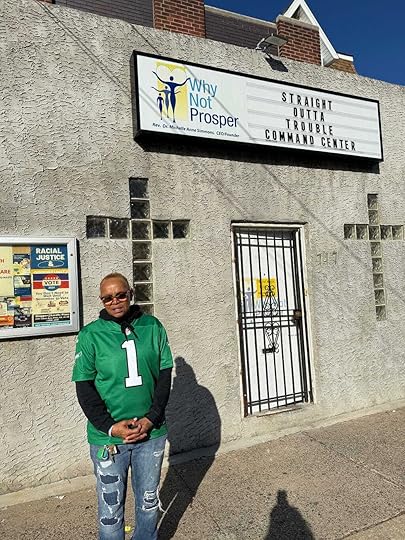 Faith at Why Not Prosper Headquarters, Philadelphia, PA
Faith at Why Not Prosper Headquarters, Philadelphia, PAVolunteering often stirs a complex mix of emotions. We may start with the desire to do good, but the experience can profoundly change us, revealing our own vulnerabilities and the shared humanity that connects us all.
When I signed up for a prison simulation exercise through my Women’s Connection group, I had no idea how deeply it would affect me.
The organization behind it, Why Not Prosper, was founded by Rev. Dr. Michelle Simmons. Inspired by her own experience of incarceration, she decided to support others like her. This grassroots approach immediately spoke to the power of personal wisdom in driving change.
As part of the exercise, we were all given a name and post-release scenario. I was “Harriet,” newly released after five years in prison. The seemingly insurmountable obstacles to reintegration overwhelmed me. Each station in the room represented a unique challenge: getting identification, finding transportation, securing employment, and locating housing. In the seven minutes allowed per station, I never seemed to have the correct document for the next stop on the way to living “on the outside”. The experience was a jolt to the senses about how much we take for granted in our cushy lives.
My journey didn’t end with the simulation. A subsequent opportunity to assemble “Love Bags” for women in a Philadelphia correctional facility brought me face-to-face with the real impact of incarceration. As part of the experience, we also agreed to serve a Thanksgiving meal the next day. Along the way, I met Faith, a 60-year-old operations manager for Why Not Prosper.
Faith’s story is a testament to resilience. Growing up with an alcoholic mother, she shouldered adult responsibilities from a young age.
As the oldest, it was up to her to get her brother and sister off to school, then feed them dinner. Mom’s drunken rages and beatings prevented her from a basic education. A six-year stint in the army followed, but after that, a life of dependency and prison.
As we served Thanksgiving dinner in the prison gym, the atmosphere was a mix of hope and stark reality. White tablecloths and flowers adorned the tables. Watching the women arrive in groups of thirty-five, the diversity of their stories and the common thread of humanity that bound us all, struck me.
… genuine kindness often requires stepping out of our comfort zones and confronting tough realities
This experience taught me that genuine kindness often requires stepping out of our comfort zones and confronting tough realities. It showed me that vulnerability — both in those we serve and in ourselves as we open our hearts to their struggles — is not a weakness, but a powerful catalyst for connection and change.
I learned, most importantly, that we all have the ability to help others. It’s a power we all possess, regardless of our past or present circumstances. Faith’s transformation from a life of addiction to one of service is a convincing reminder that everyone has the capacity to make a difference, no matter how dire their situation may seem.
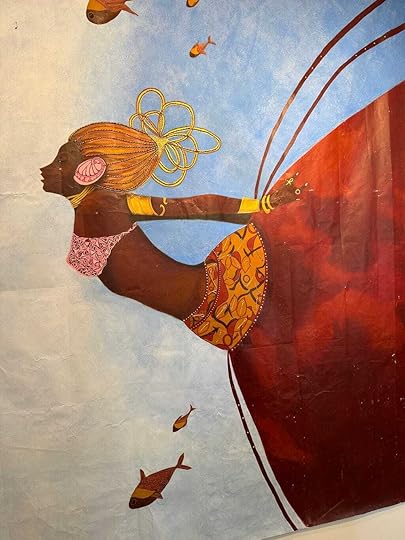 Painting at the Formerly Incarceration Renaissance Museum (F.I.R.M.)
Painting at the Formerly Incarceration Renaissance Museum (F.I.R.M.)I asked Faith, what was the turning point for her to leave drugs and become Reverend Michelle’s right hand?
“Reverend got the best out of me when I could not see it in myself. The Lord keeps me strong.”
Faith’s journey from thirty-years of addiction to a college degree, then becoming a pillar of support for other women, was inspiring. Her words, “I gave myself forgiveness. I don’t want to live that life,” resonated deeply, highlighting the power of self-compassion in the face of past mistakes.
As I looked around at the women sharing a meal, each with their own complex journey, I was humbled by the realization that change often starts with one person extending a hand of kindness. In that moment, the line between volunteer and beneficiary blurred, and I understood that in helping others, we often find healing for ourselves.
Anna Maria DiDio is an author whose memoir and adoption-themed children’s books and more can be found on her website: amdidio.com . Her latest book, Grace’s Write Time, is a middle grade chapter book about friendship and belonging.
[image error]In Prison For a Day was originally published in New Writers Welcome on Medium, where people are continuing the conversation by highlighting and responding to this story.
November 26, 2024
The ScaryTruth About Being Next
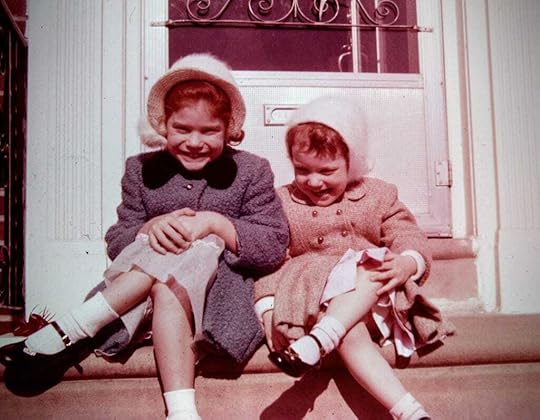 My sister Mary (left) and me, copycat style on the front steps of our home
My sister Mary (left) and me, copycat style on the front steps of our homeGetting older is the worst sort of elimination diet. People, places, food and god knows what else, are constantly being removed from my life — only at the end, I know that nothing will be returned to my plate.
At least that’s how I felt when my sister passed away.
Mary was two years older and I have thought a lot about her these last few months.
Truthfully, we were not super close. When we got together, it was therapeutic to dissect the parental dynamic in our home. She had a big laugh and we traded bittersweet memories.
A few years ago, we had lunch to talk about alternative living arrangements for our mother. We didn’t agree on much but the facts were clear. Our mother had started to wander out of the house and I was worried. Mom was in her late eighties and had been fiercely independent, still living in the home where we grew up.
We needed to act quickly — my father died over fifteen years earlier. His early onset dementia was a shock and we watched helplessly as Alzheimers claimed him.
Mary previously had been the one to provide primary assistance to Mom as she was not working. I pressed for a more full time solution as my sister was not dependable, disappearing for days at a time. Mom needed full-time care.
What was going on with my big sister?
I eventually had to proceed on my own and by that I mean: decide on an extended care facility; get a bridge loan to pay for it; sell our family home to pay back the loan with enough to finance the ongoing nursing care residence; apply for Veteran’s benefits because every little bit helped.
When Mary gave me Mom’s checkbook, things just did not add up. To clarify, I don’t mean that in a blame game way. The account was a confusing mess.
It was tough to get my sister’s attention to help sort out the house as we prepared to sell. How could I be losing them both?
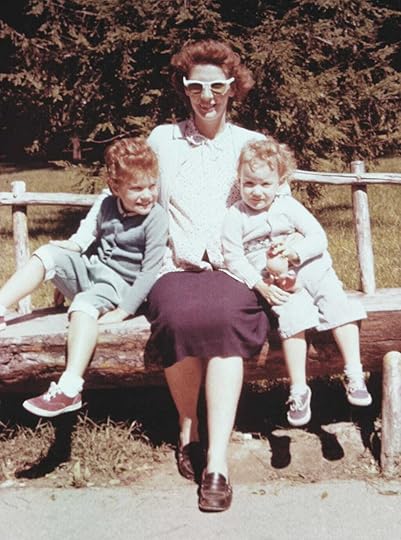 Mary, Mom and me in the fresh air
Mary, Mom and me in the fresh airWhen mom passed away, I was ready or as ready as you can be to lose a parent. It seemed consistent with the natural order of things. Mom was almost ninety-three, and had advanced cognitive decline and a host of physical ailments.
Shortly after that, Mary was diagnosed with Lewy body dementia. People often confuse it with Alzheimer's but patients with Lewy body suffer not only from memory issues but also visual hallucinations, motor symptoms and sleep behavior disorder.
As a family, we knew that something was wrong. But the finality of the diagnosis was crushing.
At the same time the elimination diet continued:
My husband lost a kidney to cancer. I googled “chances of recurrence” repeatedly on my phone.My job was “eliminated” but not really because someone took my place.My eldest daughter moved away and then my other daughter moved to Europe for a study abroad experience.We sold our home and downsized to condo living.Chicken korma was out — so were deep squats and pickleball. While on a walk the other day, I saw someone using a cane. Ugh, I thought. I’d rather stay home.
Granted, some of these events were planned. Others were a function of time, bone density and just plain aging.
The truth about being next is that it’s unavoidable and can easily morph into a crushing self-absorbed weight about mortality. When I bring up life planning issues or moving to a place with no stairs, my daughters minimize. It’s natural. No one wants to talk about it.
For months after Mary’s funeral, when I couldn’t find my phone, or recall a name, a chill would stop me cold. Has it started?
But recently, something has clicked and it is definitely related to the fact that the world is not as I imagined it would be … not as I want it to be.
If I don’t change things, who will?
I am more determined than ever to keep my plate full by doing the following:
Connect with long lost friends.Reach out to those that could use my help; be generous, be of service, be of use to those in need.Begin writing that next book.Record moments of joy.Be grateful for the family I have and treat them as the most precious humans in my life.Experience new things and write about it.Travel, work out, swim, jog (slowly), bake, read, write and try to understand the world for as long as I am able.Whenever I am successful at one of these tasks, I will celebrate and stay determined.
Too many things have slipped away. So much has been removed from my life whether I wanted it to or not. It’s time to banish the elimination diet forever. I cannot outrun the inevitable but I can create my own feast.
Anna Maria DiDio is an author whose memoir and adoption-themed children’s books and more can be found on her website: amdidio.com . Her latest book, Grace’s Write Time, is a middle grade chapter book about friendship and belonging.
[image error]The ScaryTruth About Being Next was originally published in New Writers Welcome on Medium, where people are continuing the conversation by highlighting and responding to this story.
September 23, 2024
Equine Therapy

Equine therapy is a therapeutic approach that uses interactions with horses to help children address emotional and trauma-related issues. Children engage in activities with horses, like grooming, leading and feeding. It’s the relationship with the horse that is key; the non-verbal communication between these powerful, gorgeous animals help children to explore their emotions.
This is a hands-on experience with horses that is carefully monitored by trained mental health professionals. Equine therapy sessions are particularly helpful for children who have struggled with traditional talk therapy.
Equine therapy and adoptionEquine therapy can be particularly helpful for adopted children and is featured in my new book Grace’s Write Time. Yes, horses can actually help adopted kids heal. Grace is book smart but has trouble making friends. She meets Andy, who is adopted who then recruits her for a top secret mission: to find his birth mother. Andy’s equine therapy is all part of the identity he so desperately seeks.
The benefits of equine therapy go beyond the adoption world and offer a unique approach to helping children manage many different types of trauma-related issues. One-on-one with a horse goes a long way to foster emotional regulation, trust-building, and non-verbal communication. Horses provide immediate feedback to a child’s emotional state, helping them learn to control their responses and build confidence.
Being in the therapy environment reduces stress and anxiety, while mastering tasks with the horses enhances self-esteem. Without directly confronting trauma, children can process emotions in a safe, non-judgmental space, making equine therapy an effective complement to traditional therapeutic methods.
Equine therapy can benefit people of all ages and a variety of conditions, including physical disabilities, learning disabilities, substance use disorders, eating disorders, abuse or accident survivors, personality disorders and intellectual disabilities.
Equine-assisted therapy is a powerful tool for improving mental health with many emotional, psychological, and physical benefits.
Anna Maria DiDio is an author whose memoir and adoption-themed children’s books can be found on her Amazon author page . Her latest book, is Grace’s Write Time .
[image error]September 22, 2024
Beans, Garlic, and Silence: Discovering My Father’s Untold Stories
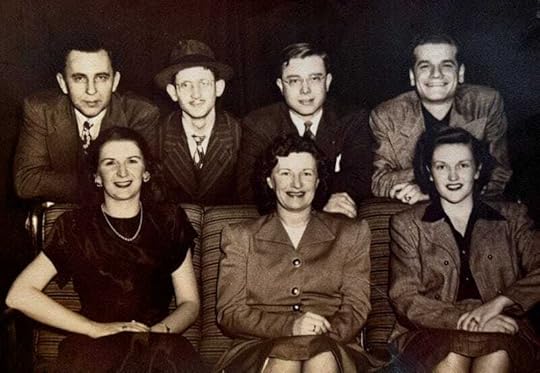 My father is top right in the mid 1905’s at the start of his advertising career
My father is top right in the mid 1905’s at the start of his advertising careerMy father’s birthday was earlier this month and I couldn’t stop thinking about him. He passed over fifteen years ago and as I continue to write about my own parenting journey, there are more questions than ever.
Raised in a small Philadelphia Catholic neighborhood, his parents came to the United States from Italy as children. Sadly, I don’t know much more than that.
There was much scrimping and saving. My father would not permit my mother to ever prepare any kind of bean dish for dinner, telling us that he had eaten too many beans as a kid. Plus he hated garlic. What Italian doesn’t like garlic?
Why didn’t I ever ask him about these food issues? What exactly did he eat as a kid?
One of his favorite stories was from his altar boy days. The family lived very close to their church and he served mass frequently from an early age.
However, one Sunday, the priest told him to leave in the middle of mass. My father had inherited his larger-sized brother’s shoes which were making loud clopping noises on the altar.
Why didn’t I ever ask him, was money that tight? What kind of job did my grandfather have?
As kids, we always want something from our parents. My dad’s job took him to center city each day and so he was not around much during the week. At dinner, he said that he talked all day and wanted some “peace and quiet” as he enjoyed his meal. On the weekends, there were four of us asking: take us swimming, pump up our bike tires, check our homework, let’s play a game.
“Aspettt, aspett,” he would say. I didn’t know what that meant, just that he was putting me off. Then I would begin to pester him even more.
It wasn’t until I was watching an Italian movie years later that I heard the word, which prompted me to look it up. He was telling me to wait … wait.
Why didn’t I ever ask him about being a parent, being a father … what did he do for fun when he was a kid?
He was a determined guy, I do know that. Saint Joseph’s College in 1953 never saw a more earnest student. Smart enough to work in the science labs , he earned extra cash. A natural at math, he was intent on finding a “creative writing job,” and decided to major in English.
The one thing I thought I knew about my dad was — he wasn’t funny.
He worked many years as an advertising creative director, winning a Clio in the humor category. Imagine my surprise.
The language, the beans, the garlic were all reminders of a life he wanted to leave. What kind of life was he looking for? Now, I would give anything to know more.
Do you know your father’s most defining trait? I decided to gather the most famous DADs from the entertainment world and quiz my readers about their most endearing quality.
How do we remember our Dads? This will get you started …
Download the What Kind of Father? quiz and choose the most memorable trait for each of the well-known film and TV dads. Then think about your father’s defining style and let me know in the comments.
What ONE word you would choose for your dad?
My father’s word: Striving
Thanks Dad, I learned from the best. I strive to be a better mom, wife, writer and human every day.
Anna Maria DiDio is an author whose memoir and adoption-themed children’s books can be found on her Amazon author page. Her latest book is Grace’s Write Time .
[image error]July 9, 2024
Hat, Haircut, and Tattoo Decisions: Then and Now
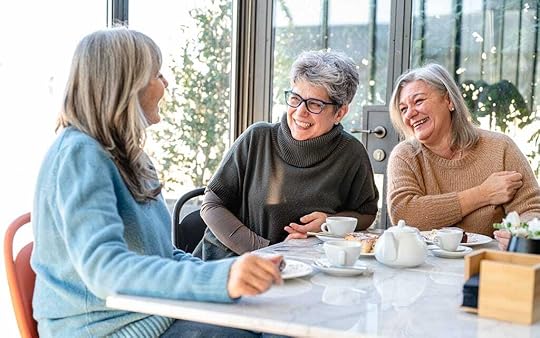
Writer James Clear talks about three different types of decisions. Most are like hats; see how it fits and it you don’t like it, try another. This is when I try on five different outfits before going out to dinner.
Other decisions are like haircuts. It may not be the right path at first blush, but it will work out eventually. I immediately thought of the infinite number of times and ways I tried to straighten my mess of curls. There was never a chance that my hair would be pin straight, so why not try every remedy in the book to see what would work?
Then there is the tattoo decision. You gotta live with whatever mistake you made. Tattoo removal is an option, but like a bad decision, correction is painful. Marriage, children, career choices fit in this category.
One of the best decisions I made years ago was to join a group called Women’s Connection. The dues were for a twelve-month period, more than enough time for the haircut to grow out. Women’s Connection is an organization for women over fifty years of age offering meaningful social opportunities in any area you can think of. The Philadelphia Chapter has over four-hundred members who read books, go to movies, happy hours, museums, restaurants, volunteer gigs and more. You get the picture.
There is a unique opportunity within Women’s Connection to join a “peer group.” As an additional way to forge connections — ten to twelve women are assigned somewhat at random and typically meet monthly to discuss topics or issues important to them.
At our July meeting, we delved into the decision making paradigm mentioned above. Here is what I learned.
When I took inventory on the decisions that I have made throughout my life, they ran the gamut of hats, haircuts and tattoos. However, in my younger years, every decision felt like a make or break tattoo, when in fact they were haircuts, maybe even hats.
We drank iced tea and traded some similar stories. Predictably, children ended up being the biggest tattoo time of life. No give backs in that area. Husbands, not so much. However, it was particularly meaningful for me as I recalled signing the adoption agreement for my youngest daughter over twenty years ago. I had never been so sure and so scared.
Our adoption journey took over three years providing lots of time to process. There was something so very final about picking up our new daughter at the airport and not being able to speak a word of English to her. She was also traumatized and proceeded to cry for months on end. Tattoo or no tattoo, we questioned ourselves for quite some time.
For many of us, career decisions felt as permanent as black ink. Around the table, we laughed and marveled at how serious we were as budding professionals. To me, it feels like a lot of wasted energy now.
At the current time, my approach to decision making has changed dramatically. I said good-bye to the corporate life (or rather it said good-bye to me) years ago. Which begs the question: What constitutes a legit tattoo decision today other than your final resting place?
Recently, both of my daughters made pretty big decisions for which I had my own conflicting thoughts. Any by that I mean, conflicting with their thoughts.
These were not my decisions to make, but for my loved ones, I thought it was important to give them the tattoo treatment. I weighed in appropriately when asked, but then made the commitment not to share every thought I had about their plans. That left one course of action: to support them one hundred percent. And that was hard.
When I recalled memories of family reactions to my big decisions of years ago, those words still sting. The lack of support stayed with me for a long time.
I didn’t want those negative thoughts for my girls. What is crucial for me right now is that they know I will be there for them and support them in any way that I can.
It’s comforting to know that I have a peer group for bouncing hat, haircut or tattoo decisions. At this point in my life, tattoos are a no, haircuts are maybe and hats only matter if they are on my team. (Go Phils! and Fly Eagles Fly!)
Anna Maria DiDio is a writer and children’s author whose memoir and adoption-themed children’s books can be found on her Amazon author page.
[image error]May 21, 2024
Should Adoption Be Abolished?
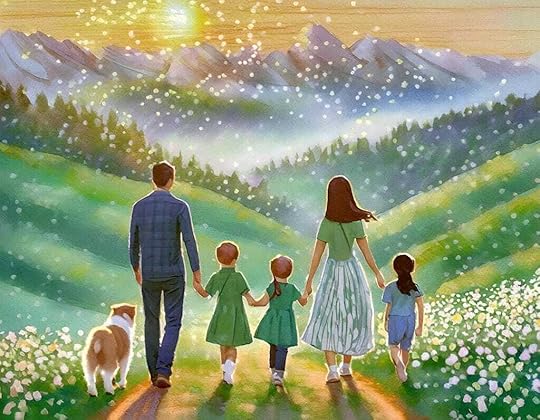 This extremist view has a legit back story
This extremist view has a legit back storyRecently, I joined an online Facebook group called “Adoption Sucks.” I wanted to get some timely inside scoop on the recommended rationale for eliminating the only hope that some have for a family.
Abolishing adoption may be a bit over the top, but the mere thought of doing away with it will help to sharpen our focus for improvement.
Adoption has been mischaracterized for years.
The entertainment world has perpetuated the myth of adoption with stories like “Annie” and many other adorable orphans. The examples are endless — each with the message that a shiny new place to live is the simple solution to creating a family.
All adoptions begin with trauma. As an adoptive parent, I did not immediately recognize the trauma triggered by the primal wound. When hearing the news of our adoption, friends and family remarked “she’s so lucky to have you as her family.” I bought into this line of thinking for years.
We adopted our daughter at age seven from Mexico and it took me too long to acknowledge that her behavior was the result of trauma.
More accurately, she experienced trauma many times over in leaving her native country. One day she went to sleep in the beautiful town of Cuernavaca, home to all of her childhood memories. The next day, she lived in suburban Philadelphia in a new house full of strangers.
She was so wanted and so loved, but even a loving family cannot take away the pain of adoption trauma.
My daughter lost her language, culture, tastes, smells, as well as her caregivers. She cried for months. Over the years, her resilience has amazed me. We knew it was important to maintain the relationships formed in Mexico. This has made a difference in her life and how she views her adoption. The cultural roots of adopted children must be preserved and celebrated.
The rants against adoption continue to cite the same issues. We can do better to improve by considering the following:
Biological and/or cultural connections are precious and are often minimized or overlooked. When possible, biological ties should be preserved. If there are any extended family members, those connections should be fully explored, pertinent medical information recorded and available to the adoptee.
Denying children critical information about their health is just wrong. Kiddos are left wondering about crucial medical history.
Birth certificates should be made available to adoptees. My home state of Pennsylvania changed the law to allow adoptees access (with some restrictions) to birth certificates in 2017. Unrestricted access to a birth certificate is rare. I have read about adoptees in their 60's and 70's who have never seen their birth certificate.
The fees charged for adoption services are extreme and out of range for most families. Decisions should be made in the best interest of the child and not just for those who can afford adoption services. The for-profit model should not apply to an adoption agency.
Open adoption arrangement that suits both parties must be maintained when possible. The mental and emotional health benefits of an open adoption are well known. When possible, an open adoption arrangement that suits both parties must be maintained.
Parents — whether biological or adoptive — can indeed “suck.” Not everyone is cut out to be a parent. Adoptive parents actively choose that route, so when their parenting is terrible, it’s a travesty. That’s why I am so passionate about the unique mission of my children’s stories. What better way to engage in a conversation about trauma than with the help of a kid’s picture book?
If I can reach one parent who will acknowledge trauma and initiate that discussion, I will be ecstatic. To explore an adopted child’s thoughts about his/her first family must not be viewed as a slight by the adoptive family. Adoptees should feel free to question and delve into their birth stories just as biological children do.
I am often asked about the advice I would give to those considering adoption. My answers are first, seek out other adoptive families. Get the facts about their process. What were their hurdles, current problems and solutions? Build a supportive community.
Second, do your research. There are so many resources in the form of books, articles, support groups, and even adoption coaches. Become familiar with adoption theories and best practices.
Finally, seek professional help. Even before adopting, examine the reasons behind your desire for a family. After adoption, find a therapist who specializes in adoption. As our daughter grew and family issues shifted, we would look into what would be the best resource for her. I wanted to provide a space for her to speak to someone else — when she would not speak to me.
So — NO! I don’t think adoption should be abolished. However, the system should be overhauled top to bottom with children at the center of everything.
Awareness begins at the local level. If considering adoption, check your state laws and agencies in your area for specifics around these issues.
Adoptive families must be brutally honest about the importance of children knowing where they came from, who they look like and how their story began.
Anna Maria DiDio is a writer and children’s author whose memoir and adoption-themed children’s books can be found on her Amazon author page.
[image error]April 8, 2024
My Catholic Girl Seder
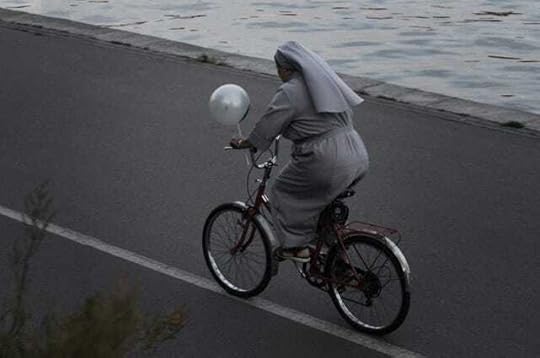 Photo by Viktor Talashuk on Unsplash
Photo by Viktor Talashuk on UnsplashMy first and only Seder was in high school. At the time, I did not appreciate the forward thinking of Sister Timothy. With Passover approaching, my thoughts turn to the significance of religious ritual. Do I need to call one church “home” for religious observance?
Sister Timothy (never “Tim”) was small, round and always had a smile. Her World Cultures class was way ahead of its time, highlighting and appreciating cultural events in the world. It was April 1972. What did a bunch of Catholic School girls at Villa Joseph Marie High School know about Passover? Nothing. Sister Timothy did not have to look far to stretch our minds. I am so thankful she did.
Sister Timothy organized a Seder meal during our class time. The desks were lined up in a tight row across the classroom. White table cloths, paper plates, plastic cups, matzah and other foods were distributed. We began with a sip of apple juice while Sister Timothy explained the symbolism of the bitter herbs.
We were probably giggling or rolling our eyes.
I remember breaking the matzah — to be eaten later in the Seder. Sister Timothy read the story of the Israelites’ liberation from slavery in Egypt, including the Four Questions and the recitation of the ten plagues.
We all took turns reading but probably just looked forward to eating.
The apples, nuts and juice plus the other piece of matzah were enjoyed at the end of our “service.” Over the years, I marveled as friends told me of their family Seder dinners and how they celebrated. I tried many times to wrangle an invitation in hopes of participating in the real thing. It hasn’t happened yet.
In the Catholic tradition of Lent, my family observed meatless Fridays. Holy Thursday and Good Friday services were slow, reflective events where we contemplated sin and sacrifice. Easter Sunday was chocolate and honey baked ham.
Passover, although also a solemn event, has the spirit of family and community that I am reminded of every year.
This year at Easter, I found myself church shopping, looking for a meaningful experience, seeking to capture … I don’t even know what. For years our family attended a wonderful Presbyterian church in our hometown. Now at a new downsized and empty-nest address, I have not settled on a church home.
What is magical and wonderful about the Seder, from my Catholic school girl lens, is that it is experienced with family and friends. At the Episcopal high mass, there was a foot washing, communion, and incense so thick I started to sneeze. It was a beautiful service, but I was there alone and ultimately left feeling empty.
Easter service at another church—this time with my husband in attendance—felt much more like a community celebration. Should I join a church to be more fully immersed in this feeling of community?
Yesterday, after speaking to a friend about my wonderings, she has invited me next year for Seder. I was thrilled and wondering what I should bring.
Until then, my honey baked ham is in the oven.
[image error]March 4, 2024
Life in the Variable Lane
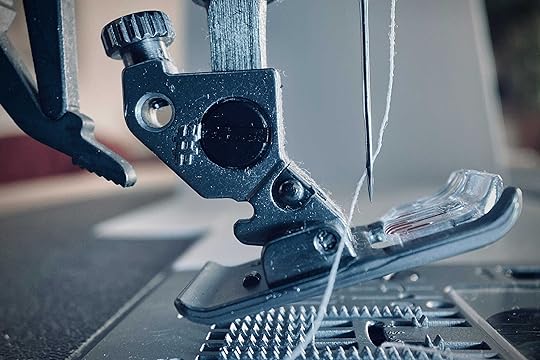 Thomas Wolter — Unsplash
Thomas Wolter — UnsplashQuarantine had drained my energy. It was the third rainy day in a row as I sat in a funk with piles of shredding all around me. The gift of endless amounts of time at home had forced a necessary slow down of my life and I was determined to tidy things up.
The sun finally came out and I pulled open a cabinet that held yards of fabric and incomplete sewing projects. I had forgotten about most of them including a stack of twelve-inch quilting blocks made for my daughter.
The cotton felt soft as I examined the seams, looking to see if I had lined up the blocks in a straight line. It had been years since I worked on a quilt. Thankfully, there were enough squares for a full-size bedspread.
Why had she chosen this particular pattern? I went to my quilt book to look up the name. The page was marked with a sticky note: Variable Star. Perfect.
The truth was that life with my daughter was more than variable. It was downright tumultuous at times. Adopted at age seven from Mexico, she struggled with her identity beginning with screams in Spanish that she did not want to learn English. After a few months she lost her native tongue and spoke English almost exclusively; an added trauma that I did not fully appreciate. We tried to restart Spanish lessons many times, but our efforts fell flat. It was not until college that her first language was fully reclaimed. Mastery included completing a difficult study abroad experience. We were so proud of her.
Now in her twenties, she moved out a year ago after we did not see eye-to-eye on a number of issues. Communication was strained and only when we had to. Our rules had suffocated her and she was determined to find her own path. She didn’t go very far. Instead of blazing a new trail, she moved in with her boyfriend.
Unfortunately, the space between us only grew wider.
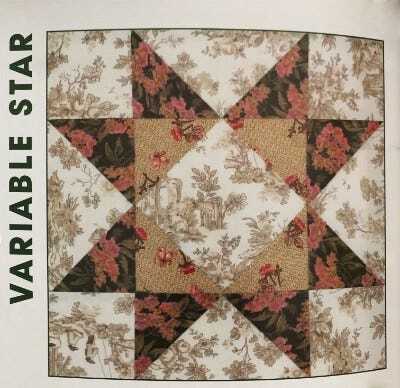
Variable Star
What a perfect description of our life and lesson for me. Variable: not consistent or having a fixed pattern; liable to change; able to be changed or adapted. Yeah — no kidding.
I tried to reach out many times. Text messages were ignored. Once, we met for dinner and ended up accusing each other of many things over tacos.
Then, tragedy struck. Her boyfriend passed away suddenly. She moved home for a short while wanting nothing more than to sit in her old room alone while wearing his sweatshirt. I coaxed her to seek out friends and “talk to someone” about her grief. She agreed.
Eventually, we helped her get settled in a new apartment.
The holidays were forced and unpleasant. The fog lifted just a sliver in the new year and ever so slowly, we started to connect again. She was still the queen of one-word responses. But then, as our world began to hang on an elastic mask strap, I wanted to do something more.
I pulled out my quilting supplies and began attaching all of the blocks. While my hands were busy, my mind was focused on repairing this relationship. We kept our social distance for the most part. During one visit, she smiled when she saw the quilt partially put together. “I remember picking the fabric.”
While my life could be described perfectly by straight lines and squares, my daughter’s routine resembled more of a crazy quilt. There were no lines or predictable patterns to her way of thinking. Her plans were always changing and it was still difficult for her to be honest with us about how she was doing.
The quilt turned out beautifully, with a dark border and black thread in a leaf pattern. My phone buzzed to tell me that the variable star was on her bed. We had not texted or interacted on social media recently. But now she loved the quilt with many emoji hearts and would I help her to look for pillows? Baby steps.
In a year where every day looked the same, I learned a valuable life lesson. Look for the small changes. Seemingly insignificant things will make a huge difference in our lives. Embrace change. Adapt…not because you have to…but because you want to. “Variable” is the only way to live.
Anna Maria DiDio is a writer and children’s author whose memoir and adoption-themed books can be found on her Amazon author page.
[image error]Life in the Variable Lane was originally published in Human Parts on Medium, where people are continuing the conversation by highlighting and responding to this story.
October 14, 2023
Why Barbie Was Never Going to Speak to My Child
As the date to see Barbie approached, my thoughts ran wild with possible story lines and costume changes. In anticipation of our cinema girls meetup, I put on a bright pink t-shirt and opened my Barbie doll case from the 60’s. Even when we downsized, I could not find it in my heart to give it away.
Inside, Barbie, Midge and Skipper were dressed to impress. My sister and I played endless imaginary scenes in high-pitched voices, dressing and undressing Barbie and friends.
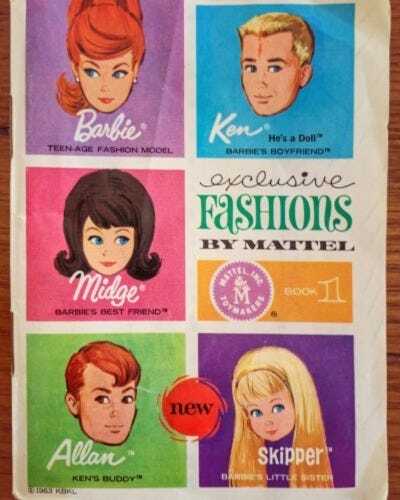 The teeny 3" X 4" FASHIONS BY MATTEL catalog with models: Barbie, Midge, Ken, Skipper and Allan.
The teeny 3" X 4" FASHIONS BY MATTEL catalog with models: Barbie, Midge, Ken, Skipper and Allan.Midge was my favorite. Why? Because she looked like me — a brunette tomboy sporty girl — or at least I anointed her as such. Blonde Barbie was a too glamorous for my taste (too much eyeliner!).
I identified with Midge due to the one thing that I was reminded of every day of my childhood. My mother, two sisters and brother all had a major head of bright red curly hair, while my hair was straight and mousy brown, typically cut pixie style.
When we were out and about, strangers would admire, then cluck at me, “Where did you come from young lady?” If there was a five-year-old version of screw you, I would have said it.
My dad had dark brown hair, but he was never with us shopping or running errands. He was my biological link to the family and proof that I belonged.
Even good natured teasing made me feel like the odd kid out.
My own daughters had a different route to Barbie. The oldest was an only child up to the age of eight, and very assured of her place, not just in the family, but in the world. She had our undivided attention all those years and knew she could be anything that she wanted to be.
Her Barbies were purchased with a very specific relatable purpose, i.e. Baseball Barbie for the time she played in a youth softball league, etc. For the most part, Barbies stayed in the box.
My youngest daughter, adopted at age seven from Mexico, could not relate to perfection in pink. Plus, she did not look like me or her dad.
It should not have been a surprise that she refused to wear a hand me down hot pink Barbie bathing suit. She ran out of the room when I held it up before our family swim at the local pool.
All adoptions begin with the trauma of separation and loss which is referred to as the primal wound.
Who do I look like? Where did I come from?
Adopted children are grieving the family that is unknown to them.
Barbie’s career choices were not relatable at all to her. She had bigger fish to fry at that age — like learning to speak English.
Unfortunately, at the time, I was a bit clueless at all she had lost: her culture, sights, smells, food, caregivers. Toys and dolls were the least of her problems.
Barbie was never going to happen. Family survival mode kicked in and we gravitated to someone that she could relate to: Dora.
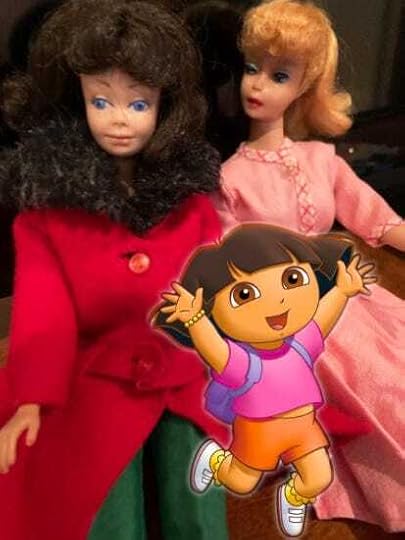 Author’s vintage Midge and Barbie circa 1964 plus Dora
Author’s vintage Midge and Barbie circa 1964 plus DoraWhat a joy it was watching her mimic Dora and learn those first few English words.
Blended or bio, families of all shapes and sizes must be aware of the a child’s individual needs regardless of how they came to be in that family.
Here are three things that I found helpful to move my blended family forward:
Acknowledging our need to belong is critical. Where do I fit in this world? I learned to be patient and sensitive, accepting and empathetic to the emotions exhibited due to trauma: crying, anger, difficulty with relationships.Wondering about first family roots is normal and healthy even when the adopted family experience is positive and loving. The pain about the family that is unknown is constant and forever.Working through the pain is vital and means talking it out, crying it out — grief is a complicated emotion. We shared the road to our adoption story early and often with no secrets.At every opportunity, I tried to send the message: you are ours, we love you, we are here for you.
Adoptees seek a state of acceptance — not from their adoptive parents — but from themselves, their roots, their relinquishment. These are huge hurdles.
My daughter will live with her grief forever. However, loss, trauma and grief do not define her. She continues to grow stronger every day.
Anna Maria DiDio is author of the memoir Love at the Border, An Adoption Adventure, plus three adoption themed children’s books and a Philadelphia sports fan. To learn more about her writing and adoption resources visit amdidio.com. She’s on Instagram @amdidio.
[image error]Why Barbie Was Never Going to Speak to My Child was originally published in Be Yourself on Medium, where people are continuing the conversation by highlighting and responding to this story.
May 15, 2023
Accept Adoptee Anger
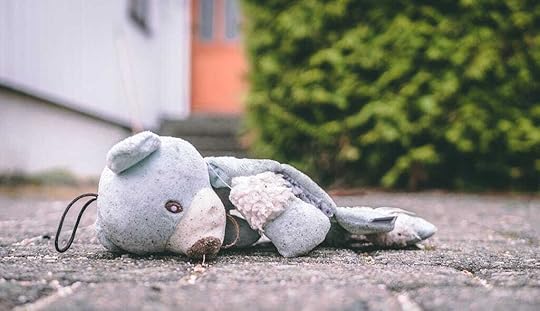 Photo by Trym Nilsen on Unsplash
Photo by Trym Nilsen on UnsplashAdoption begins with the trauma of separation and loss. How your child manages that fact is crucial for development and coping.
When we adopted our daughter at seven years old, there were days that grew into years of tears, angry tantrums and words that could not be taken back… on both sides. It’s hard not to react to — you’re not my real parents!
Our adoption journey began with only the best of intentions, however the daily struggle to ensure that she felt safe, secure and loved, was painful, rewarding, unexpected yet predictable. Adoptee anger is real.
These top five suggestions for coping are rooted in honesty. See if any of the following resonate for you.
First, be honest with yourself and your child as to why you adopted. From the beginning of my marriage, I knew that I wanted a family. Divorce delayed the plan and my bio clock was ticking. When I re-married, thoughts of a family took an urgent turn. All told, it was ten years of fertility treatments until we finally had a beautiful baby girl. Adding to our family proved impossible and that is how thoughts turned to adoption.
Our adopted daughter was a precocious seven-year-old brought to an orphanage in Cuernavaca, Mexico when she was just a baby. Our biological daughter was eight at the time of the adoption.
My sister and I have always had a close relationship and I wanted that for my daughters. However, it seemed like I was constantly waiting for the magic to happen. Our daughters have completely opposite personalities. Your family must take its own path. I had to let go of the sisterly bonding fantasy I had in my head.
Second, educate yourself about trauma and the primal wound. Love is not the only answer to the harmonious family life you seek. Your child may have deep-seated issues related to the multiple traumas of relinquishment.
As much as I wanted to love, hug and cuddle with my new daughter, she was having none of it. Trust must be built gradually and earning that trust was difficult. I communicated with my tone of voice as much as I could. Our experiences together as a family got us part way there. As the years have passed, she remembers those family traditions fondly and that makes me smile.
Acknowledging her trauma and letting go of my naive expectations was a long and difficult journey. It was, however, the only way our family moved forward.
We were trained, we were counseled yet the depth of her anger and struggles somewhat blindsided me. A loving family did not take away the pain of the family that she never knew.
Third, support outreach to the biological connections of your child’s first family. Things change as your child grows. Different levels of understanding about the adoption process will take hold as the distinctions between the first family and the adoptive family become apparent. If there is a desire for bio family connections, support from adoptive parents is essential.
My daughter lived almost seven years in Mexico and had strong ties to her native country. We have encouraged and maintained those ties over the years.
Fourth, connect to a therapist that is familiar with adoption issues, but steel yourself if progress is (painfully) slow. As much as I wanted to have all of the answers for my daughter, it was important for me to give her the opportunity to talk to someone else. This is not a statement about parental competency. I felt very confident in the family culture that we were creating, but an expert opinion is invaluable to every family.
Carve out your own time for healing. This journey will test you and your partner in many unexpected ways.
Therapist expertise should also change as your child grows. In the beginning, a play therapist helped us to jump start family communication. Later, in her teen years, the issues became more complex and we needed a different intervention.
Fifth, don’t give up under any circumstances. The energy and resources that you dedicate to your child may result in a breakthrough that you did not anticipate.
My daughter took ballet lessons in Mexico from a very young age. We continued instruction until it was apparent that her interest waned, but strongly encouraged her to complete the year with her class. By then, high school athletics had taken over and that became her priority. It was a positive change that she controlled.
Try any and all ideas. Call on your motherly/fatherly instincts. There is no one path to the family you seek. Regardless of what you try, the anger will be there. Adequate preparation will help you to deal, and move your family forward. Watch carefully for those breakthrough moments of progress. I am rooting for you!
Anna Maria DiDio, MSW is an author and speaker who writes children’s books about adoption trauma, separation, and grief. Her books and more can be found at www.amdidio.com
[image error]Accept Adoptee Anger was originally published in Be Yourself on Medium, where people are continuing the conversation by highlighting and responding to this story.



